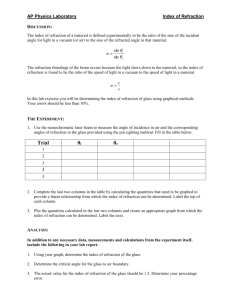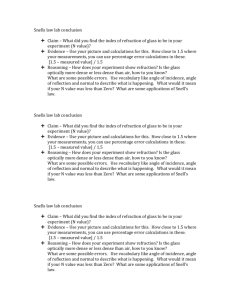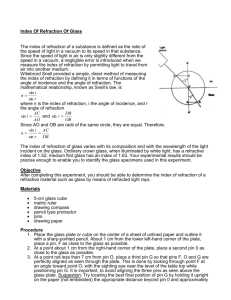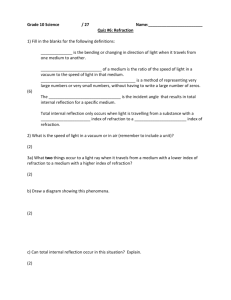PEEKSKILL HIGH SCHOOL
advertisement
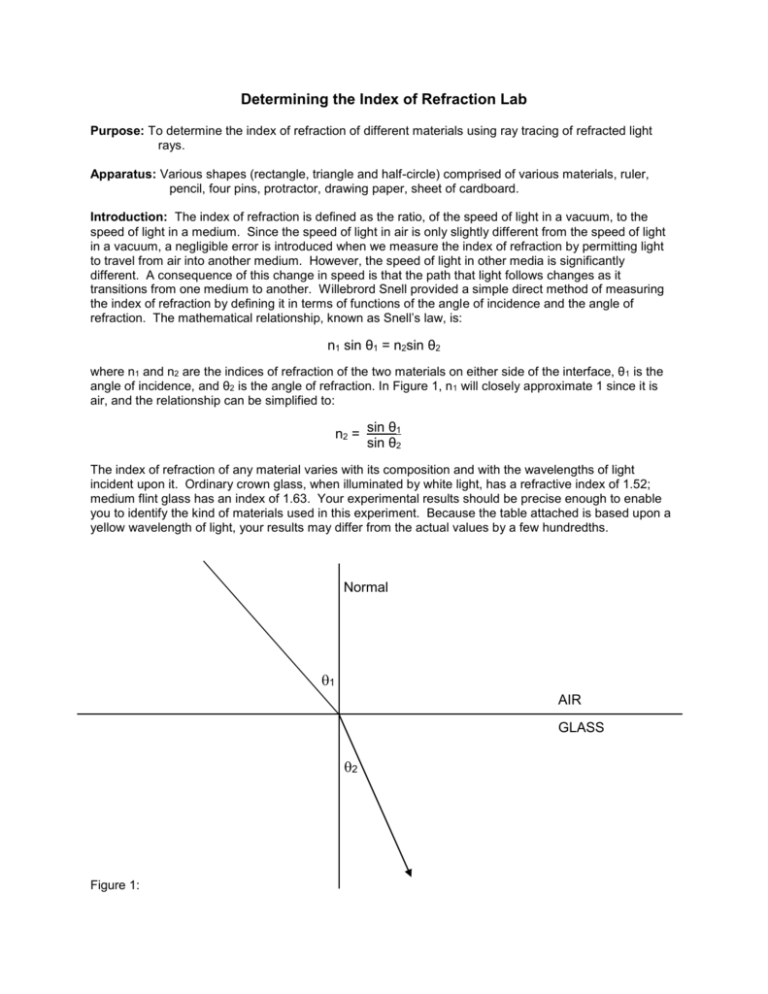
Determining the Index of Refraction Lab Purpose: To determine the index of refraction of different materials using ray tracing of refracted light rays. Apparatus: Various shapes (rectangle, triangle and half-circle) comprised of various materials, ruler, pencil, four pins, protractor, drawing paper, sheet of cardboard. Introduction: The index of refraction is defined as the ratio, of the speed of light in a vacuum, to the speed of light in a medium. Since the speed of light in air is only slightly different from the speed of light in a vacuum, a negligible error is introduced when we measure the index of refraction by permitting light to travel from air into another medium. However, the speed of light in other media is significantly different. A consequence of this change in speed is that the path that light follows changes as it transitions from one medium to another. Willebrord Snell provided a simple direct method of measuring the index of refraction by defining it in terms of functions of the angle of incidence and the angle of refraction. The mathematical relationship, known as Snell’s law, is: n1 sin θ1 = n2sin θ2 where n1 and n2 are the indices of refraction of the two materials on either side of the interface, θ 1 is the angle of incidence, and θ2 is the angle of refraction. In Figure 1, n 1 will closely approximate 1 since it is air, and the relationship can be simplified to: n2 = sin θ1 sin θ2 The index of refraction of any material varies with its composition and with the wavelengths of light incident upon it. Ordinary crown glass, when illuminated by white light, has a refractive index of 1.52; medium flint glass has an index of 1.63. Your experimental results should be precise enough to enable you to identify the kind of materials used in this experiment. Because the table attached is based upon a yellow wavelength of light, your results may differ from the actual values by a few hundredths. Normal 1 AIR GLASS 2 Figure 1: Procedure: 1. Place the rectangular glass shape on the center of a sheet of blank paper and outline it with a sharp pencil. 2. About 1 cm from the lower right-hand corner of the plate place pin C as close as possible to the glass (See Figure 2). 3. At B, 1 cm from the upper-left hand corner of the glass plate, stick a second pin, as close to the plate as possible. At D, not less than 7 cm from C, stick a third pin so that B is in line with C and D as seen through the glass plate. Keep the eye you sight with near the level of the tabletop. (DO NOT ALIGN THE PINS WITH B AND C AS SEEN OVER THE GLASS PLATE.) 4. Place an additional pin at A, not less than 7 cm from B that is aligned with the other three pins. 5. Remove the glass plate, and join the points, A, B, C and D to represent the path of the light traveling from pin D through the air to C, through the glass to B and back to air to A. Identify the incident ray DC and the refracted ray CB. 6. From C construct the normals, NC and CN’ to the line EF (EF is the side in which pin C was up against). 7. By means of a protractor, measure the angles of incidence, θi1 and θi2, and the angles of refraction, θr1 and θr2. Record this data, then use it to compute the index of refraction using the ratio of the sin’s as described in the introduction. 8. Repeat this process in similar fashion for the triangular piece of material. 9. Fill the half circle container with water about half way. Then repeat the process twice more for the half circle. Place pin B at the “center” of the flat side of the half-circle. Then place pins A, C and D in two locations such that two rays will enter at angles greater than 0o less than 90o. 10. On each drawing, show your work for determining the index of refraction for the unknown material. A N Θr2 B N’ Θi2 1 cm Pins Θr1 E N’ C F Θi1 Glass Block Figure 2: N D Data: Trial Θi1(°) Θr1(°) Index of Refraction (sin θi1 / sin θr1) Θi2(°) Θr2(°) Index of Refraction (sin θr2 / sin θi2) Avg. Rectangle Triangle HalfCircle Analysis: 1. What is the size of the angle of refraction if the angle of incidence is 0? 2. What is meant by the critical angle? 3. Compare rays DC and BA for the rectangular block (see figure 2). What can you say about their relationship to one another? 4. Using your experimental results, try to identify the type(s) of material(s) that you used in this experiment using the values you calculated? Explain any discrepancies that you feel may exist. 5. Determine the speed of light in each of the materials, using your average value for the index of refraction and the relationship v = c/n. Show all your work! Error Analysis & Conclusions: Absolute Indices of Refraction (f = 5.09 x 1014 Hz) Air 1.00 Corn Oil 1.47 Diamond 2.42 Ethyl Alcohol 1.36 Glass, Crown 1.52 Glass, Flint 1.66 Glycerol 1.47 Lucite 1.50 Plastic 1.46 Plexiglas 1.50 Polystyrene 1.55 Quartz, Fused 1.46 Quartz, Crystalline 1.54 Sodium Chloride 1.54 Water 1.33 Ice 1.31 Zircon 1.92


